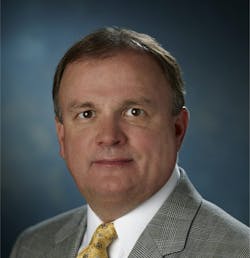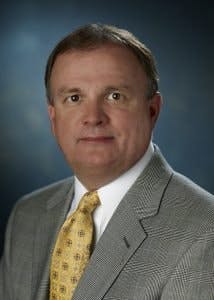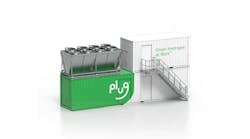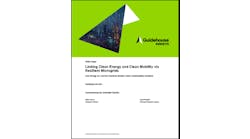PowerSecure, a subsidiary of Southern Company, has developed 125 advanced microgrids and manages more than 1,700 microgrids and advanced distributed energy sites. Below Mark Martyak, chief sales officer of PowerSecure-Distributed Infrastructure, explains in an interview with Kevin Normandeau, publisher, Microgrid Knowledge, how microgrids can become a “non-spinning substitute for spinning reserves,” which is crucial as we add more renewable resources to the grid.
An example of a PowerSecure microgrid. Photo courtesy: PowerSecure
Who does PowerSecure serve and what differentiates the company in the marketplace?
Mark Martyak: We are a turnkey life cycle/provider of microgrids at the grid edge. Our customers are utilities and large energy users.
Our microgrids are currently serving many mission critical market sectors including: healthcare, data centers, military, pharmaceuticals and retail. We are able to align the needs of our utility partners with those of their premiere customers, to create applications that result in vastly improved resiliency, and environmental sustainability under commercially viable financial terms.
Utilities gain the grid support that they need including; peak load management, demand response, intermittent power shortage mitigation, frequency response, and a “non-spinning” substitute for spinning reserves, which has tremendous environmental advantages. Customers gain a 100% standby power, and similar environmental benefits at reduced costs or an attractive ROI.
What are non-spinning substitutes for spinning reserves, and how do microgrids serve in this capacity?
MM: Great question. We all want more renewable sources, less emissions and as close to zero carbon as we can get in today’s environment, right? However, renewable resources are intermittent by nature. So, the more renewable resources that are connected to the grid, the greater the impact on the stability of the grid: i.e. what happens to grid stability, especially during peak days, when the sun goes behind a cloud or the wind stops blowing?
In order for the grid to remain stable, utilities must provide reserve capacity that is on-line, operational and capable of immediately addressing load variations or unexpected loss of on-line, fully-utilized capacity. This is referred to as spinning reserve. (Spinning reserve is unused capacity that can compensate for power shortages or frequency drops within a given period of time.)
Currently the vast majority of spinning reserve consists of fossil fuel resources, because it must be “always-ready” to operate for indefinite periods of time. As renewable resources increase, so does the need for spinning reserve. We also refer to this as “firming” renewable resources.
Our microgrids become non-spinning substitutes for spinning reserve, because they can provide large quantities of power or frequency support to the grid with an extremely fast response (zero- to 20-second timeframe) and operate for indefinite periods of time as required to provide compensation of power shortages or frequency drops without spinning 24/7.
Our microgrids are only activated and operate in parallel with the utility as long as they are needed. In contrast, if a utility brings up a peaking gas turbine plant as a spinning reserve asset, it will typically run for days or more, even if it’s no longer needed, because cycling of large turbines is not good practice. — Mark Martyak, PowerSecure
Our microgrids are only activated and operate in parallel with the utility as long as they are needed. In contrast, if a utility brings up a peaking gas turbine plant as a spinning reserve asset, it will typically run for days or more, even if it’s no longer needed because cycling of large turbines is not good practice. In contrast, our microgrids can be online a few seconds, minutes or hours, only as absolutely necessary to stabilize the grid and then shut down. We can cycle our microgrids as many times a day as needed for the utility. This keeps the utility from running spinning reserve.
Mark Martyak, chief sales officer of PowerSecure-Distributed Infrastructure
As we continue to add renewable energy to the grid, what will happen if we do not add firming capability?
MM: As renewable portfolios grow, we advocate an equal amount of “always-ready”, low emissions firming assets be provided. That is exactly what our microgrids do.
I’ll give you a prime example. For years, Germany touted their large portfolio of PV. However, as the PV capacity grew, they neglected to provide clean firming assets and had to revert back to using their old coal fired plants to firm their PV supply. This has resulted in a much higher emissions and extremely high cost of electricity. Please search “Germany’s Energy Crisis,” and a wealth of material will come up to support my comments.
MM: We have a 25 MW microgrid at the Marine Corps Air Station (MCAS) in Yuma, Arizona. Yuma happens to be at the very end of the California ISO (CAISO). Thus, even though its located in Arizona, Yuma actually experiences all the power shortages and frequency issues associated with the large renewable portfolio connected to CAISO. In a way, every frequency event on the CAISO “ends up in Yuma.” The MCAS 25 MW microgrid supports the APS Grid, CAISO and at the same time provides 100% resiliency to MCAS.
Arizona Public Service (APS) and PowerSecure created the MCAS microgrid, including a joint patent pending technology called Autonomous Frequency Response, where we apply, fast start, run-up-synch super clean diesel generation to support the grid automatically and within CAISO required timeframes.
PowerSecure uses the term “Microgrid 360″ to describe its service. What does that mean?
MM: The Microgrid 360 terminology refers to our turnkey, lifecycle approach to microgrid technical applications. It also refers to our “360” perspective of both our utility and energy user needs, including: energy efficiency, resilience, utility reliability, emissions reduction and cyber security. We serve our customers throughout the life of our reliable, low emissions and cost effective microgrids… that’s what truly makes PowerSecure unique.
Not only do we develop, design and build our microgrids, we then monitor and maintain all our microgrids on a 24/7 basis every second of the day and every operation, whether it’s a power outage, black start, peak load management, coincident peak load management, or autonomous frequency control event. We continuously know the exact operating status of all our microgrids across the country.
The 24/7 monitoring of over 1.6 GWs of microgrids today and our 20-year history, has resulted in what we believe is the the largest microgrid data base in the U.S. In addition, all our data is sent automatically to Mtechnology for reliability and failure analysis. This discipline has resulted in PowerSecure having the highest third-party verified reliability in the industry.
Mark Martyak is the chief sales officer of PowerSecure-Distributed Infrastructure.
Kevin Normandeau is the publisher of Microgrid Knowledge.









